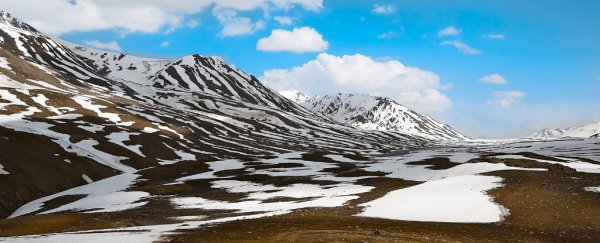Climate change is pulling back the curtain and exposing an Arctic landscape not seen by the Sun in 40,000 years or more.
Baffin Island is a rocky, frozen wonderland, located in the Arctic circle between Greenland and the northern coast of Canada. With its deep fjords and ancient glaciers, it's the perfect place to study ice age patterns.
Geologist and paleoclimatologist Gifford Miller from University of Colorado Boulder has been travelling here nearly every summer for the past 40 years, and the changes he has uncovered are disturbing.
Today, the Arctic is warming two to three times faster than the rest of the world. If the trend persists, Miller thinks it's just a matter of time before all the glaciers on Baffin Island disappear completely.
"Unlike biology, which has spent the past three billion years developing schemes to avoid being impacted by climate change, glaciers have no strategy for survival," explains Miller.
"They're well behaved, responding directly to summer temperature. If summers warm, they immediately recede; if summers cool, they advance. This makes them one of the most reliable proxies for changes in summer temperature."
Walking along the margins of these rapidly melting glaciers, Miller and his team have been unearthing ancient moss and lichens, preserved under an icy blanket for millennia.
Now, however, with climate change stealing more and more of the covers, some of these ancient plants are beginning to wake from their natural slumber.
"The strange thing about these mosses is that a lot of them can just start growing again, so they're the closest thing to a zombie that I know of, the living dead," said Miller in a short film on the topic.
In August last year, the researchers collected 48 samples of vegetation from the edges of 30 different Baffin ice caps, as well as some samples of nearby quartz.
Using radiocarbon dating, the researchers figured that these plants have been frozen in time for at least the past 40,000 years, and possibly for as long as 120,000 years.
The most conservative estimates take us back to the last ice age, when average temperatures were colder than they are today, and woolly mammoths were still hunted by humans. This is likely when the island's plateau of tundra was buried by the ice we see today, encasing its plants in a tomb that wasn't meant to be opened so soon.
But nowadays, thanks primarily to human activity, the heat we are experiencing is enough to reverse thousands of years of natural changes. When compared to temperature data from Arctic ice cores, the findings suggest that this century is the warmest the region has experienced in some 115,000 years.
These are unprecedented changes, lying far outside the range of natural variability, and touching nearly every corner of Baffin Island.
"You'd normally expect to see different plant ages in different topographical conditions," says lead author Simon Pendleton, an expert in glacial geology at the University of Colorado Boulder.
"A high elevation location might hold onto its ice longer, for example. But the magnitude of warming is so high that everything is melting everywhere now."
"We haven't seen anything as pronounced as this before."
If nothing changes, the authors predict that in the next few centuries, the island could be utterly free of all ice.
This study has been published in Nature Communications.
